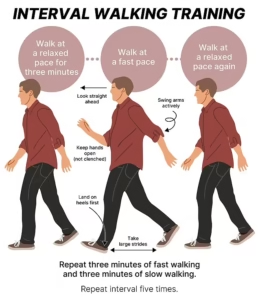Japanese walking

Japanese walking is becoming the latest fitness craze – taking over trendy workouts like Pilates, yoga and spin classes
The exercise consists of bursts of slow and fast walking, which increases your heart rate. Also known as the ‘3-3 walking workout’, you walk with intensity for three minutes, then slow down for the next three. This is repeated five times, totalling 30 minutes
It was developed by Professor Hiroshi Nose and Associate Professor Shizue Masuki at Shinshu University in Matsumoto, Japan, to help elderly people experience the health benefits of athletes undertaking high-intensity interval training
The three-minute benchmark is when the researchers found that most of the older citizens tended to get tired
You’re advised to take longer strides in the fast intervals while bending the elbows and swinging he arms to help maintain the correct form
Participants in the study experienced a host of health benefits, including weight loss and lower blood pressure. Thigh strength and physical fitness also improved
A later 2018 study by the same researchers found that over a ten-year period, those who did interval walking reported greater protection against the reductions in strength and fitness that happen with ageing
The Japanese walking method has also been hailed for helping to regulate blood pressure and boost your VO2 max – a numeric measure of your aerobic capacity which reflects how well your heart, lungs, and muscles work together to deliver and use oxygen for physical activity
The higher this is, the greater your cardiovascular fitness, and it even translates to a longer lifespan, according to a study in the Journal of the American College of Cardiology
Who Should (and Shouldn’t) Try Japanese Walking?
Anyone striving to increase their overall fitness level can benefit from interval walking. It may also help those of you wanting to lose weight or challenge yourselves with a higher-intensity workout. It’s especially useful for people who are short on time but want a more efficient form of exercise
However, if you have a history of heart or lung problems or difficulty balancing, talk to your doctor before starting any exercise program. Also, avoid working out intensely (or check with a healthcare provider first) if you have an injury or recent surgery. People who don’t typically exercise should start slowly and ease into the fast-walking intervals
There are a few things to consider with this new walking trend. In the 2007 study, around 22 per cent of people did not complete the Japanese walking programme. For the lower intensity programme, with a target of 8,000 steps per day, around 17 per cent did not complete it. This means that Japanese walking may not be suitable for everyone, and it might not be any easier or more attractive than simple step-based targets
Achieving a certain number of steps per day has also been shown to help people live longer. For those aged 60 and older, the target should be around 6,000 to 8,000 steps a day and 8,000 to 10,000 for those aged under 60. Similar evidence does not appear to exist for Japanese walking… yet
So is this walking trend really the be-all and end-all? Or does it matter less about what exercise you do and more about how often and how hard you do it? The answer is likely to be the latter
Research tells us that people who regularly perform more bouts of moderate to vigorous physical activity live longer, regardless of how long each bout is
This means that we should focus on ensuring we perform regular moderate to vigorous physical activity and make it habitual. If that activity happens to be Japanese walking, then it’s a worthwhile choice
Leave a reply
You must be logged in to post a comment.







